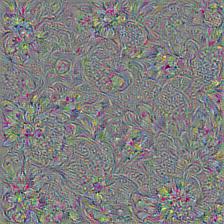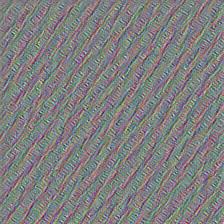机器学习: DeepDreaming with TensorFlow (一)
在TensorFlow 的官网上,有一个很有趣的教程,就是用 TensorFlow 以及训练好的深度卷积神经(GoogleNet)网络去生成一些有趣的pattern,通过这些pattern,可以更加深入的去了解神经网络到底学到了什么, 这个教程有四个主要部分:
1:简单的单通道纹理pattern的生成;
2:利用tiled computation 生成高分辨率图像;
3:利用 Laplacian Pyramid Gradient Normalization 生成各种有趣的视觉效果;
4:生成类似 Deepdream的图像;
这个教程还提供了一个生成pattern的图像库,
http://storage.googleapis.com/deepdream/visualz/tensorflow_inception/index.html
在这个库里,可以看到神经网络每一层上生成的pattern。
在学习这个教程之前,请确保你已经安装好了Tensorflow 以及 Jupyter.
这个教程里的所有pattern都是基于训练好的Googlenet 生成的,Googlenet 网络先在 ImageNet 上进行了足够的训练。
先看第一部分:
简单的单通道纹理pattern的生成
# boilerplate code
from __future__ import print_function
import os
from io import BytesIO
import numpy as np
from functools import partial
import PIL.Image
from IPython.display import clear_output, Image, display, HTML
import tensorflow as tf
# 运行以下这句代码将训练好的网络模型下载解压到本地:
!wget https://storage.googleapis.com/download.tensorflow.org/models/inception5h.zip && unzip inception5h.zip
model_fn = 'tensorflow_inception_graph.pb'
# creating TensorFlow session and loading the model
# 加载模型
graph = tf.Graph()
sess = tf.InteractiveSession(graph=graph)
with tf.gfile.FastGFile(model_fn, 'rb') as f:
graph_def = tf.GraphDef()
graph_def.ParseFromString(f.read())
t_input = tf.placeholder(np.float32, name='input') # define the input tensor
imagenet_mean = 117.0
t_preprocessed = tf.expand_dims(t_input-imagenet_mean, 0)
tf.import_graph_def(graph_def, {'input':t_preprocessed})
# 获取网络的层数以及总的通道数
layers = [op.name for op in graph.get_operations() if op.type=='Conv2D' and 'import/' in op.name]
feature_nums = [int(graph.get_tensor_by_name(name+':0').get_shape()[-1]) for name in layers]
print('Number of layers', len(layers))
print('Total number of feature channels:', sum(feature_nums))
# Picking some internal layer. Note that we use outputs before applying the ReLU nonlinearity
# to have non-zero gradients for features with negative initial activations.
# 选择某些中间层,以及某个通道
layer = 'mixed4d_3x3_bottleneck_pre_relu'
channel = 139 # picking some feature channel to visualize
# start with a gray image with a little noise
# 先生成一个噪声图像
img_noise = np.random.uniform(size=(224,224,3)) + 100.0
def showarray(a, fmt='jpeg'):
a = np.uint8(np.clip(a, 0, 1)*255)
f = BytesIO()
PIL.Image.fromarray(a).save(f, fmt)
display(Image(data=f.getvalue()))
def visstd(a, s=0.1):
# Normalize the image range for visualization
return (a-a.mean())/max(a.std(), 1e-4)*s + 0.5
def T(layer):
# Helper for getting layer output tensor
return graph.get_tensor_by_name("import/%s:0"%layer)
def render_naive(t_obj, img0=img_noise, iter_n=20, step=1.0):
t_score = tf.reduce_mean(t_obj) # defining the optimization objective
t_grad = tf.gradients(t_score, t_input)[0] # behold the power of automatic differentiation!
img = img0.copy()
for i in range(iter_n):
g, score = sess.run([t_grad, t_score], {t_input:img})
# normalizing the gradient, so the same step size should work
g /= g.std()+1e-8 # for different layers and networks
img += g*step
print(score, end = ' ')
clear_output()
showarray(visstd(img))
render_naive(T(layer)[:,:,:,channel])
我们看看生成的效果图:
layer = ‘mixed4d_3x3_bottleneck_pre_relu’ channel = 139
layer = ‘mixed3b_3x3_bottleneck_pre_relu’ channel =10
layer = ‘mixed3a_3x3_bottleneck_pre_relu’ channel =20
机器学习: DeepDreaming with TensorFlow (一)的更多相关文章
- Google机器学习课程基于TensorFlow : https://developers.google.cn/machine-learning/crash-course
Google机器学习课程基于TensorFlow : https://developers.google.cn/machine-learning/crash-course https ...
- 机器学习:DeepDreaming with TensorFlow (三)
我们看到,利用TensorFlow 和训练好的Googlenet 可以生成多尺度的pattern,那些pattern看起来比起单一通道的pattern你要更好,但是有一个问题就是多尺度的pattern ...
- 机器学习:DeepDreaming with TensorFlow (二)
在前面一篇博客里,我们介绍了利用TensorFlow 和训练好的 Googlenet 来生成简单的单一通道的pattern,接下来,我们要进一步生成更为有趣的一些pattern,之前的简单的patte ...
- ML.NET 发布0.11版本:.NET中的机器学习,为TensorFlow和ONNX添加了新功能
微软发布了其最新版本的机器学习框架:ML.NET 0.11带来了新功能和突破性变化. 新版本的机器学习开源框架为TensorFlow和ONNX添加了新功能,但也包括一些重大变化, 这也是发布RC版本之 ...
- 初入机器学习,安装tensorflow包等问题总结
学习python,机器学习(maching-lerning).深度学习(deep-learning)等概念也是耳熟能详.我最近从新手开始学习maching-learning知识,不过课程偏向基本的理论 ...
- 人工智能新手入门学习路线和学习资源合集(含AI综述/python/机器学习/深度学习/tensorflow)
[说在前面]本人博客新手一枚,象牙塔的老白,职业场的小白.以下内容仅为个人见解,欢迎批评指正,不喜勿喷![握手][握手] 1. 分享个人对于人工智能领域的算法综述:如果你想开始学习算法,不妨先了解人工 ...
- TensorFlow机器学习实战指南之第一章
TensorFlow基础 一.TensorFlow算法的一般流程 1.导入/生成样本数据集 2.转换和归一化数据:一般来讲,输入样本数据集并不符合TensorFlow期望的形状,所以需要转换数据格式以 ...
- 学习tensorflow之mac上安装tensorflow
背景 听说谷歌的第二代机器学习的框架tensorflow开源了,我也心血来潮去探探大牛的产品.怎奈安装就折腾了一天,现在整理出来备忘. tensorflow官方网站给出的安装步骤很简单: # Only ...
- Tensorflow学习笔记1:Get Started
关于Tensorflow的基本介绍 Tensorflow是一个基于图的计算系统,其主要应用于机器学习. 从Tensorflow名字的字面意思可以拆分成两部分来理解:Tensor+flow. Tenso ...
随机推荐
- 【57.14%】【codeforces 722B】Verse Pattern
time limit per test1 second memory limit per test256 megabytes inputstandard input outputstandard ou ...
- Hadoop入门经典:WordCount 分类: A1_HADOOP 2014-08-20 14:43 2514人阅读 评论(0) 收藏
以下程序在hadoop1.2.1上测试成功. 本例先将源代码呈现,然后详细说明执行步骤,最后对源代码及执行过程进行分析. 一.源代码 package org.jediael.hadoopdemo.wo ...
- 事件处理之二:点击事件监听器的五种写法 分类: H1_ANDROID 2013-09-11 10:32 4262人阅读 评论(1) 收藏
首选方法二! 方法一:写一个内部类,在类中实现点击事件 1.在父类中调用点击事件 bt_dail.setOnClickListener(new MyButtonListener()); 2.创建内部类 ...
- jquery中的this与$(this)的区别总结(this:html元素)($(this):JQuery对象)
jquery中的this与$(this)的区别总结(this:html元素)($(this):JQuery对象) 一.总结 1.this所指的是html 元素,有html的属性,可用 this.属性 ...
- 小强的HTML5移动开发之路(47)——jquery mobile基本的页面框架
一.单容器页面结构 <!DOCTYPE html> <html> <head> <title>Jquery mobile 基本页面框架</titl ...
- php实现 合并表记录(需求是最好的老师)
php实现 合并表记录(需求是最好的老师) 一.总结 一句话总结:php数组,桶. 1.fgets的作用? 读取一行 0 1 2.如何读取一行中的两个数? fgets()读取一行后explode以空格 ...
- 为什么未来是全栈project师的世界?
谨以此文献给每个为成为优秀全栈project师奋斗的人. 节选自<Growth: 全栈增长project师指南> 技术在过去的几十年里进步非常快,也将在未来的几十年里发展得更快. 今天技术 ...
- PHP如何实现数据类型转换(字符转数字,数字转字符)(三种方式)
PHP如何实现数据类型转换(字符转数字,数字转字符)(三种方式) 一.总结 一句话总结: 1.强制转换:(int) (bool) (float) (string) (array) (object) 2 ...
- 流媒体协议介绍(rtp/rtcp/rtsp/rtmp/mms/hls
http://blog.csdn.net/tttyd/article/details/12032357 RTP 参考文档 RFC3550/RFC3551 Real-time Tra ...
- NOIP模拟 乘积 - 状压dp + 分组背包
题目大意: 给出n和k,求从小于等于n的数中取出不超过k个,其乘积是无平方因子数的方案数.无平方因子数:不能被质数的平方整除. 题目分析: 10(枚举\(n\le8\)),40(简单状压\(n\le1 ...



